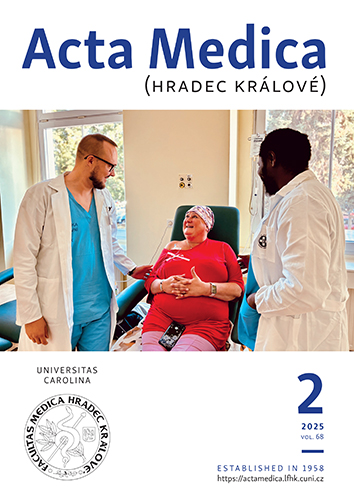ACTA MEDICA, Vol 61 No 4 (2018), 144–149
Topiramate Reduces Aortic Cross-Clamping-Induced Lung Injury in Male Rats
Aysel Kurt, Yildiray Kalkan, Hasan Turut, Medine Cumhur Cure, Levent Tumkaya, Erkan Cure
DOI: https://doi.org/10.14712/18059694.2018.133
published online: 22. 01. 2019
abstract
Background: Topiramate (TPM) decreases cytokine release and generation of reactive oxygen species (ROS). Cytokine and endothelin-1 (ET-1) secretion and ROS formation play an important role in ischemia-reperfusion (I/R) injury. We aimed to evaluate whether TPM prevents damage occurring in lung tissue during I/R. Materials and Methods: A total of 27 Wistar albino rats were divided into three groups of nine. To the I/R group, two hours of ischemia via infrarenal abdominal aorta cross-ligation and then two hours of reperfusion process were applied. TPM (100 mg/kg/day) orally for seven days was administered in the TPM treatment group. After the last dose of TPM treatment, respectively, two hours of ischemia and two hours of reperfusion were applied in this group. Results: Tumor necrosis factor-alpha (TNF-α) (p < 0.05), malondialdehyde (MDA) (p < 0.05), myeloperoxidase (MPO) (p < 0.05) and ET-1 (p < 0.05) levels of TPM treatment group’s lung tissue were significantly lower than for the I/R group. Caspase-3 and histopathological damage were rather lower than that of the I/R group. Conclusions: During I/R, lung damage occurs due to excessive TNF-α and ET-1 release and ROS generation. TPM could well reduce development of lung damage by decreasing cytokine and ET-1 release and levels of ROS produced.
keywords: topiramate; ischemia-reperfusion; lung injury; tumor necrosis factor-alpha; endothelin-1

Topiramate Reduces Aortic Cross-Clamping-Induced Lung Injury in Male Rats is licensed under a Creative Commons Attribution 4.0 International License.
210 x 297 mm
periodicity: 4 x per year
print price: 150 czk
ISSN: 1211-4286
E-ISSN: 1805-9694
